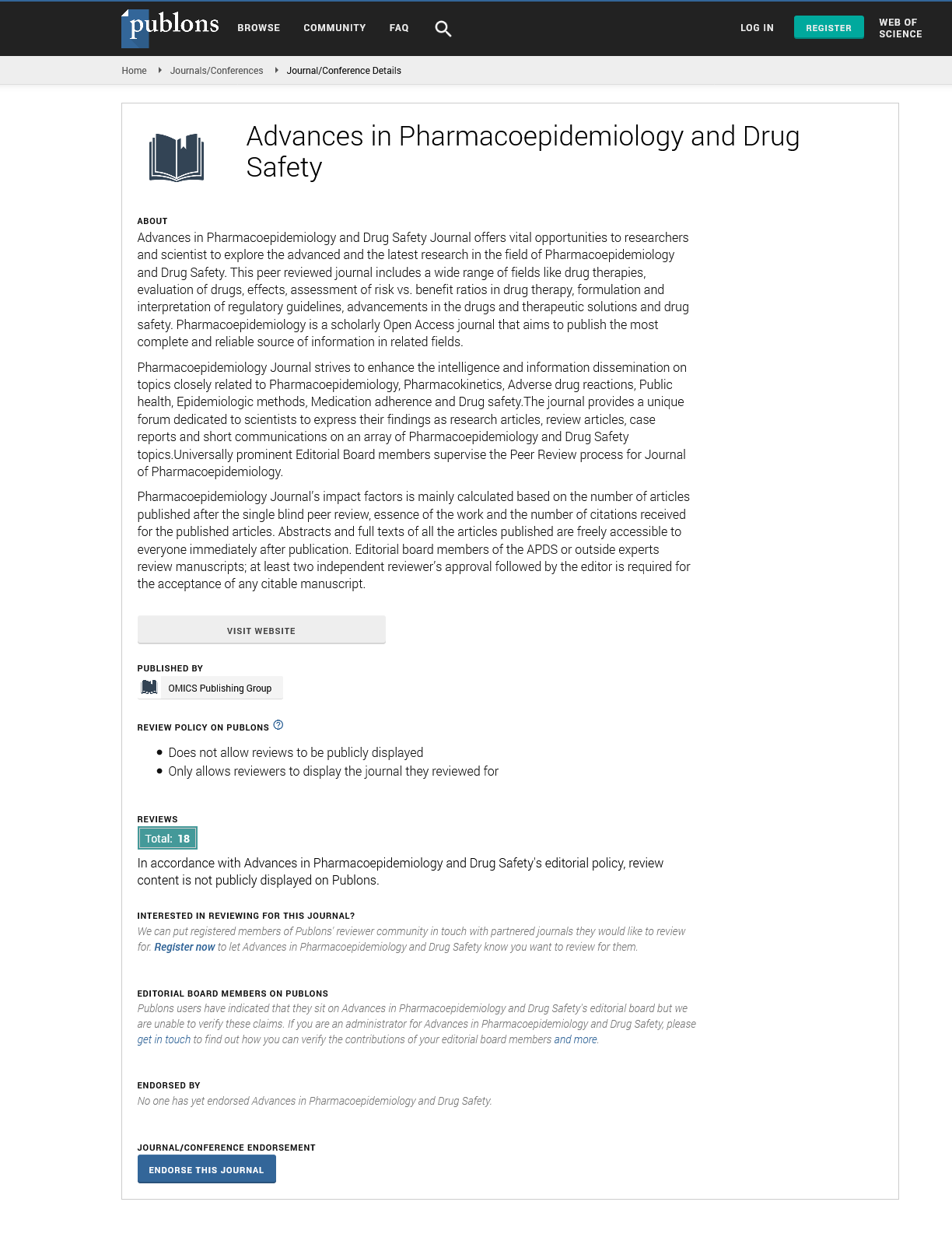Indexed In
- Open J Gate
- Genamics JournalSeek
- Academic Keys
- JournalTOCs
- RefSeek
- Hamdard University
- EBSCO A-Z
- SWB online catalog
- Publons
- Geneva Foundation for Medical Education and Research
- Euro Pub
- Google Scholar
Useful Links
Share This Page
Journal Flyer

Open Access Journals
- Agri and Aquaculture
- Biochemistry
- Bioinformatics & Systems Biology
- Business & Management
- Chemistry
- Clinical Sciences
- Engineering
- Food & Nutrition
- General Science
- Genetics & Molecular Biology
- Immunology & Microbiology
- Medical Sciences
- Neuroscience & Psychology
- Nursing & Health Care
- Pharmaceutical Sciences
Short Communication - (2020) Volume 9, Issue 3
Pharmacovigilance and Risk Management
Ryan Zia Arslaan*Received: 02-Oct-2020 Published: 27-Oct-2020, DOI: 10.35248/2167-1052.20.9.234
Abstract
Pharmacovigilance (PV or PhV), also referred to as drug safety, is that the pharmacological science concerning the gathering, detection, assessment, monitoring, and prevention of adverse effects with pharmaceutical products. The etymological roots for the word "pharmacovigilance" are: pharmakon (Greek for drug) and vigilare (Latin for to stay watch). As such, pharmacovigilance heavily focuses on adverse drug reactions, or ADRs, which are defined as any response to a drug which is noxious and unintended, including lack of efficacy (the condition that this definition only applies with the doses normally used for the prophylaxis, diagnosis or therapy of disease, or for the modification of physiological disorder function was excluded with the newest amendment of the applicable legislation). Medication errors like overdose, and misuse and abuse of a drug also as drug exposure during pregnancy and breastfeeding, also are of interest, even without an adverse event, because they'll end in an adverse drug reaction.
Keywords
Pharmacovigilance, Drug, Pregnancy
Introduction
Ultimately, pharmacovigilance cares with identifying the hazards related to pharmaceutical products and with minimizing the danger of any harm which will come to patients. For pharmaceutical companies, AE reporting may be a regulatory requirement in most countries. AE reporting also provides data to those companies and drug regulatory authorities that play a key role in assessing the risk-benefit profile of a given drug. the subsequent are several facets of AE reporting: Risk management One of the elemental principles of adverse event reporting is that the determination of what constitutes a private Case Safety Report (ICSR). During the triage phase of a possible adverse event report, it's important to work out if the "four elements" of a legitimate ICSR are present: (1) an identifiable patient, (2) an identifiable reporter, (3) a suspect drug, and (4) an adverse event. If one or more of those four elements is missing, the case isn't a legitimate ICSR. Although there are not any exceptions to the present rule there could also be circumstances which will require a judgment call. for instance, the term "identifiable" might not always be clear-cut. If a physician reports that he/she features a patient X taking drug Y who experienced Z (an AE), but refuses to supply any specifics about patient X, the report remains a legitimate case albeit the patient isn't specifically identified. This is often because the reporter has first-hand information about the patient and is identifiable (i.e. a true person) to the physician. Identifiability is vital so as not only to stop duplicate reporting of an equivalent case, but also to allow follow-up for extra information. But anonymous reporting is additionally important, as whistle blower protection isn't granted altogether countries. Note that in several countries and regions of the planet, drugs are sold under various tradenames. additionally, there are an outsized number of generics which can be mistaken for the trade product. Finally, there's the matter of counterfeit drugs producing adverse events. If in the least possible, it's best to undertake to get the sample which induced the adverse event, and send it to either the EMA, FDA or other agency liable for investigating AE reports. If a reporter can't recall the name of the drug they were taking once they experienced an adverse event, this is able to not be a legitimate case. this idea also applies to adverse events. If a patient states that they experienced "symptoms", but can't be more specific, such a report might technically be considered valid, but are going to be of very limited value to the pharmacovigilance department of the corporate or to drug regulatory authorities.
Citation: Ryan Zia Arslaan. Pharmacovigilance and Risk Management. Adv Pharmacoepidemiol Drug Saf. 2020;9(3):01-02. DOI: 10.35248/2167-1052.20.9.234

